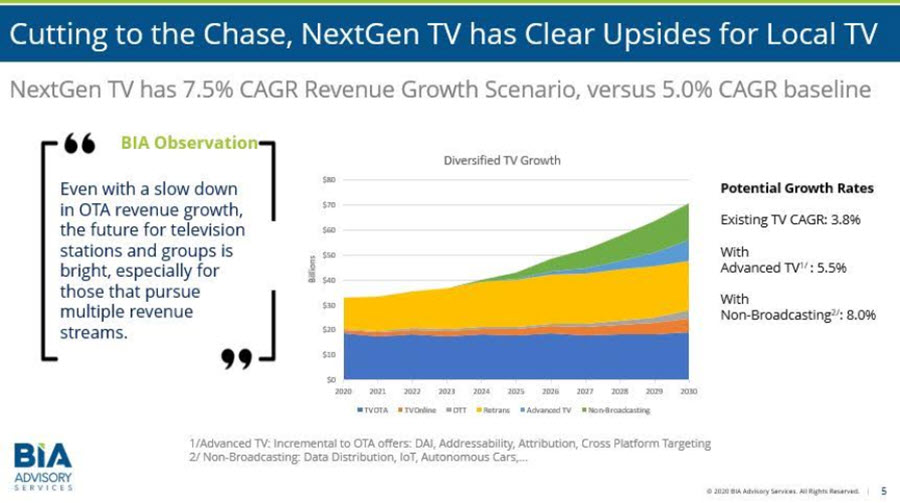Next Gen Broadcasting Will Drive Revenue Growth, Trade Group Says
But linear will continue to account for lion's share of those revs
The rollout of next generation of broadcast TV will drive 50% increases in revenue growth for TV station groups over the next 10 years, according to a new report from research firm BIA.
That would be an 8% growth rate as compared to an existing 3.8% baseline.

That next generation TV is the ATSC 3.0 transmission standard that allows for geo-targeted advertising, interactivity, data transmission, wireless backhaul, 4K video and more.
BIA released the report as part of its presentation to a D.C. chapter meeting of the Society of Motion Picture & Television Engineers Wednesday (Jan. 16).
“While a number of questions remain, there are clear upside scenarios for local TV groups investing in NextGen TV. Consumer side revenue business models will take longer to scale, but business and government business models can scale much faster," said BIA managing director Rick Ducey.
BIA was clearly high on the prospects, with one of the report takeaways billed as "“If Data is the New Oil, local TV operators might be forgiven for mistaking their towers for oil rigs." (The historic inside joke about the value of a TV station was that it was a license to print money).
But BIA cautioned that those new high-tech broadcast capabilities notwithstanding, linear TV ad and retrans dollars will continue to account for the "lion's share" of overall revenues over the next decade. In part that is because broadcasters are under no FCC timetable for rolling out ATSC 3.0, which is on a market-by-market basis.
By contrast, broadcasters were under a hard deadline for the switch from analog to digital, the last major transmission upgrade.
NEXT TV NEWSLETTER
The smarter way to stay on top of the streaming and OTT industry. Sign up below.
Contributing editor John Eggerton has been an editor and/or writer on media regulation, legislation and policy for over four decades, including covering the FCC, FTC, Congress, the major media trade associations, and the federal courts. In addition to Multichannel News and Broadcasting + Cable, his work has appeared in Radio World, TV Technology, TV Fax, This Week in Consumer Electronics, Variety and the Encyclopedia Britannica.

